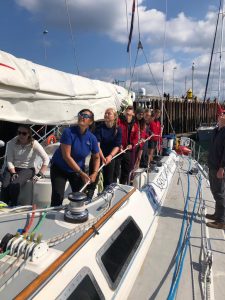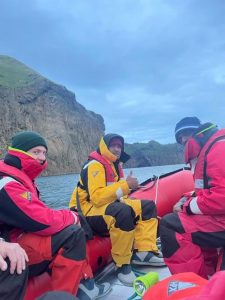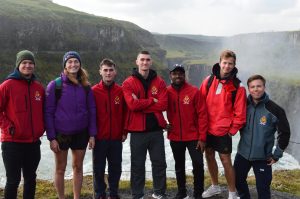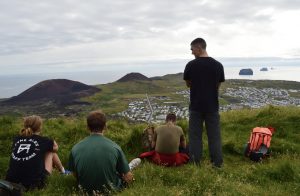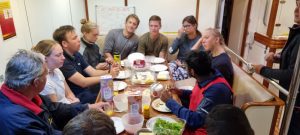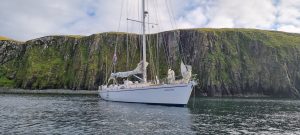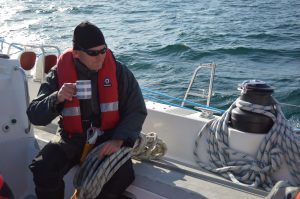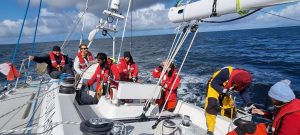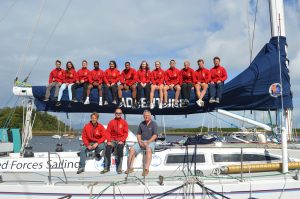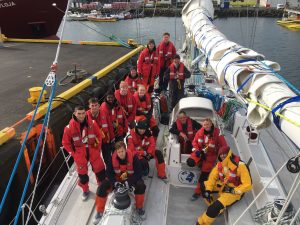On the 11th August 2022, 12 OCdts from London UOTC set out on the Ex-Arctic Express; a passage which would be split into 3 phases. The first leg, sailing from Reykjavik to Vestmannaeyjabaer (a small island off the South coast of Iceland, was helpful for developing confidence with managing the boat). Next, the longest and most exciting leg was sailing from Vestmannaeyjar to Stornoway since most of us hadn’t been away from land for that long. Finally, the last sail consisted of exploring the North West Coast of Scotland and outer Hebrides, completing our journey at Dunstaffnage marina.
Phase 1- Reykjavik to Vestmannaeyjabaer
After 18 hours of sleepless travelling overnight, it was a relief to board one of the army’s Challenger 72′ yachts. Greeted by the Skipper Maj Terence Hackett, the rules and expectations of the trip were given. As long as we could make a good brew and maintain a sense of humour, everyone was welcome!
There were 15 of us on board; the Skipper, mate and 2nd mate, ten inexperienced sailors split into 3 watches, with myself and two others as watch leaders over them, having completed our Day Skipper. We would rotate between mother duty (keeping the boat ship-shape for 24 hours, ensuring that the yacht was not ‘gopping’ and ‘pestilence-ridden’), on-watch (being on the helm and writing in the log), and off watch (getting sleep and rest!). All of us would be pushed out of our comfort zones; some physically with sea sickness and some with the mental challenge of being on an isolated boat with nothing but sea stretching into the distance. However, friendships had already started developing over the long journey to get here. Trust and teamwork would be essential for this expedition. To further the smooth running of the boat, OCdts chose a role for themselves. Myself and another OCdt were the ship’s medics. There was also a chief engineer, bosun and sailmaker; novices at first but learnt quickly on their allocated jobs.
In the morning, us watch leaders practised carrying out sail changes, putting in reefs, and my favourite part, scrambling up the mast for various jobs. While disoriented by the size of the vessel, those of us with prior experience set to work training the rest of the crew. We spent the evening climbing up the church tower and sampling some of the local jazz before retreating to slightly more familiar (and tuneful) territory.
The next day, we explored the treasures of Iceland by joining the tour of the Golden Circle. It was incredible seeing most of the famous attractions of Iceland in just one day, but more importantly, it really provided a good bonding experience for the crew in preparation for the two weeks in each other’s company. This included a visit to a place called ‘Thingvellir’ (where we walked through two continental plates), the famous geysers, and ‘Gullfoss’, the picturesque waterfall with the terrifying, deafening roar of water crashing down into the deep gulley. The support of the Ulysses Trust was key to allow this day to happen.
As we slipped lines just after midnight and set sail for the first time, the whole crew glimpsed the natural phenomenon of an erupting volcano. The smell of sulphur and plumes of smoke tickled our noses as we headed south around the headland. Brilliant bursts of orange flame and yellow flecks lit the ever-lightening sky. On our last sighting of the mainland, Iceland really came out in its full glory. Sun blazed down on the ice-cold, green marble sea, while clouds and Icelandic glaciers merged into one, dragging people out from their bunks to laze in the warmth and sip cool ginger beer. The Skipper beat all by bringing out his camping chair with a very smug smile, and seating himself in a spacious corner. Mother duty shortly handed him a brew, and he observed the scene in serenity, although sharply aware of anything that was going wrong. For some, their stomachs soon turned, unaccustomed to the pitching of the boat, and could be seen sprinting up to deck to projectile vomit over the side. By the end of the trip, all had developed sea legs and weren’t phased by the pitching of the boat.
As we approached the Island of Vestmannaeyjar, Terry called for man-overboard drill practice, getting our swimmers to dress up in the dry suits, harness and helicopter strops. Thankfully for the swimmers, no-one had to be lowered in, but we were prepared for the worst!
Stealthily, we drifted into a secret channel surrounded by ominous cliffs and menacing water which exploded onto the rock, spitting feistily like a savage cat. Puffins and seagulls screeched and circled, dive-bombing madly towards us. Suddenly stopping short, afraid of these new intruders, they retreated back to their nests in the crevices of the cliff. The harbour we pulled into was an interesting mixture of modern architecture and the backstreets of Catania. Decrepit fishing vessels spoke of roughing it in tempestuous storms, slumped against the harbour wall, but faithful to the calloused hands of their wizened masters. Fishermen buried their heads in their nordic, knitted woollen (alafoss) sweaters and oilskins, accustomed to the dribbling rain and dark sky. There was no sight of anyone else until a policeman turned up in the night asking for passports. Squat houses crawled up the hill, dotted with modern glass flats, naked and exposed against the brutal elements. Behind them, the burnt-orange turf piled up to the sleeping giants scattered with evidence of recent volcanic activity. There were no showers, but a dingy toilet lay on the opposite side of the harbour.
Making the most of being on a mooring, we spent the next couple of days training the watches how to row a dinghy, tie knots and clear the ‘snake pit’ (where all the halliard lines ran back to). I tormented them by hoisting and lowering the yankee (large foresail) until they could do it with sufficient speed to minimise exposure when the situation arose. Some amiable competition was introduced between watches as we raced to complete this task (surprisingly, my section won). They also received teaching on rules of the road, checking the engine and using the VHF. In our free time, we ran up the volcanoes, swam in the ice-cold sea, and made the most of the hot baths.
Finally, the storm had passed, the white horses had tamed into smooth rolling waves and the sun was creeping behind the clouds. There was lots to do; breakfast, lines to put to slip, and generally making everything ship-shape. The relief of heading back to sea was immense as the puffin-infested island and Iceland drifted out of view, sails picking up the wind sending the boat flying across the sea towards Scotland.
Phase 2- Vestmannaeyjar to Stornoway
The passage from Vestmannaeyjar to Scotland took 4 days, feeling longer with nothing but ocean and an occasional sighting of sea birds, whales and dolphins playing at the bow. The rotations worked effectively as we carried out our daily tasks; however, some people failed miserably at mother watch. When asked to make ‘weak tea’, someone even committed the grievous error of forgetting to put milk in the mate’s strong swamp of brown liquid. OCdts exercised huge discipline as they woke at crazy hours each night to take over from the previous on-watch, completing their 4 hour shift without complaint. All was worth it when you exited the companionway to have your breath blown away at a vast expanse of star-lit sky, free from light pollution.
My watch found it challenging to cook, make a good brew or keep a straight course at first. One of my ‘competent crew’ had no awareness of direction, steering a full 180° (jibing) and then another 270°, tacking the other way oblivious to sails soaring across his head; however, his constant morale and laughter kept spirits high. With close supervision and steadfast determination on his part, he finally learnt to stay within a 030° range. Despite many hours in each other’s company, conversation was never boring as we shared stories, poems and special interests. All of us were jazz players and thoughts emerged of forming a ULOTC band as we listened to Louis Armstrong and Duke Ellington proving that friendship and trust in the unit could be maintained even after the sailing. Although we had very different backgrounds (someone from Fiji, Pakistan, India, Spain..), beliefs and personalities everyone was respected. Those with particular strengths helped those who were struggling, encouraging them patiently until that particular skill was mastered.
Massively sleep deprived, bleary eyes scanned the horizon, lazily identifying cloud shapes and the gradients of light on the sea. As one particularly grey cloud stretching out like a sleeping cat in the distance refused to move, and with a quick confirmation to the chart plotter, the realisation slowly dawned on me. Scotland. It felt like we had been drifting for months, the promise of ‘our own island’ was a taste of fresh water to parched tongues. As if the wind had heard our thoughts, it rejoiced, propelling us along at 20kn instead of 5kn and making us heel at a rather exciting angle. A flurry of hands pulled down the main, trapping the sail and putting the wind back on a leash so that it flapped gently in time with the ‘Hebrides Overture’. After briskly tying off the lines and readjusting fenders at Stornoway, we got our heads down for a couple of hours, sailing off again in the early hours.
Phase 3- Outer Hebrides
Despite having studied the charts and drawing a pilotage plan, I was speechless as the Shiant Isles took form. The skipper’s description of ‘three rocks surrounded by water’ completely failed to capture their breathtaking majesty. The yacht cruised into the sheltered bay, breaking the silence with the chattering of the rusty anchor as it clawed into the shingle seabed. Eager to get off the boat, OCdts swam or piled into the dinghy to explore this remote treasure. As soon as I stepped onto the island, I immersed myself into its desolate tranquillity, going on a run to the farthest edge of the island; a relief after two weeks of being cooped in the boat. Other crew members felt the same beckoning silence, running in opposite directions, confirming that, an abundance of seabirds and sheep aside, this island was uninhabited. Most people were immediately drawn to the only habitable structure on the islands; an isolated Bothy door left ajar as if someone had just gone out for a breath of fresh air. We wanted to stay, but with a race against time, we reluctantly sailed away from the sun-kissed island.
The Hebrides could not have been clearer in the early morning light, as we sailed past the small isles and down the West Coast. We caught a glimpse of the colourful, picturesque houses of Tobermory, but with promises of a force 8 wind chasing us down the Sound of Mull, we continued on. Also, having spent a week on the boat gathering miles across the Atlantic, it was crazy that my watch hadn’t completed a single tack; only occasionally putting in a reef, doing minor sail adjustments and course corrections. Therefore, we practised for fun with me on the helm giving out commands; at first tentative but growing ever more confident as the crew listened attentively to my commands.
No rest for the wicked! Once Terry had completed a very impressive manoeuvre, parking the boat into a narrow space on the pontoon in Dunstaffnage marina, we were given 5 minutes for a glass of water. Then, it was straight to work tying up warps, mopping down the deck, testing for holes in the dinghy by lovingly wiping washing up liquid over it, and the odious task of pulling all of the sails out of the forepeak and throwing them onto the pontoon. We worked late into the evening, cleaning the 72ft beast, keen to have the following day to explore the sites of Oban.
The boat was handed over at 16.00 the following day, gleaming as if new under Terry’s careful inspection (‘good enough for government work’; another of his favourite phrases’). Then, to celebrate the success of the nine newly qualified competent crew, we were transformed from salty scallywags to showered, civilised humans and accepted in an Oban restaurant.
Overall
While the sailing and scenery was epic, it was the cheerful, hard-working, humour of the group that made it an adventurous training expedition none of us will forget!
OCdt Beth Lambert
Reflective statement – OCdt Beth Lambert, Watch Leader reading Medicine
Having always had a taste for adventure, I knew that I would enjoy the expedition sailing back from Reykjavik (Iceland) to Scotland (Dunstaffnage). However, I soon discovered that it was not the stunning geographical landscape or the physical activity of sailing which made the trip so memorable, but the people.
All of us faced our own challenges throughout the week; both physical and mental. Some showed immense courage and selflessness as the pitching of the sea made their stomachs turn, and yet they still continued with the cleaning and cooking without complaint. Moreover, despite being on an enormous 72 ft’ boat, some of us were nervous about being cooped up on a boat with little time to ourselves. Others feared the space of the huge expanse of water stretching out in all directions, with no sign of land; particularly when threatening weather pulled in and the boat started heeling to alarming degrees. However, the simple organisation of the watches (groups of 4 we had been placed into to ensure the smooth running of the boat) meant there was ample time to sit quietly and enjoy the scenery, while also being kept busy by sail changes and daily chores to break up the day. We soon realized the great privilege of being isolated together in a confined space with no internet or distractions, having nothing to do but share each other’s company. Protective walls were broken down as we got to know each other well, making lifelong friends.
There was a real sense of trust on board as people put others first and took responsibility for their tasks. As we neared the end of the expedition, an occasional sharp word would pass between the exhausted crews; however, I was impressed with the self-discipline and quick apologies that passed to maintain peace in the confined space. Although people had opposing beliefs and views, everyone respected each other, having the moral courage to speak out whenever anyone started speaking behind each other’s backs. People learnt to put aside their own desires, helping each other with their strengths and weaknesses, and maintaining patience and good humor in order to keep morale high.
Furthermore, I really enjoyed having the privilege to learn from the Skipper (Maj Terry Hackett). His absolute control and perception of anything that was about to go wrong, even when sleep-deprived, was inspiring. With a simple command word of ‘stop’, everyone would listen and obey. Throughout the week, despite being disorientated by the size of the vessel, us watch-leaders developed a similar assertiveness, maintaining discipline so that standards wouldn’t slip (especially when completing cleaning duties) and ensuring that orders were carried out promptly for safety. At first I found it difficult being a watch-leader, unaccustomed to being in a position of command over my peers; however, I soon realized that I needed to have authority and maintain control over my watch. I enjoyed patiently teaching my watch until they finally understood a skill or concept. It was a huge privilege to be looked up to for leadership, and to provide warmth and encouragement in order to improve confidence. It was equally as valuable learning how to have the humility to accept responsibility for our mistakes as a watch, and provide discipline accordingly so that we wouldn’t make the same mistakes again. After this exped, many of us feel more empowered to lead and have our voices heard; even in physically challenging conditions.
Overall, the success of the trip was due to the cheerful, hard-working, humour of the group, with everyone learning valuable skills, vital for many other aspects of their lives.

